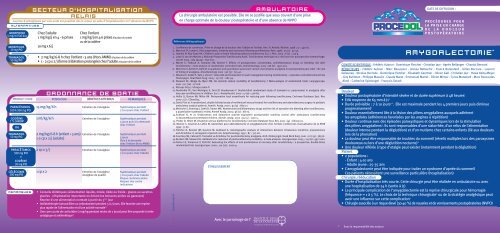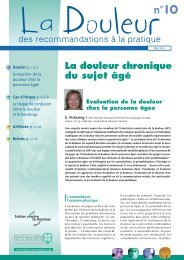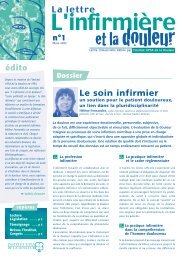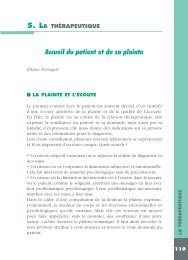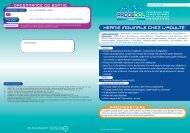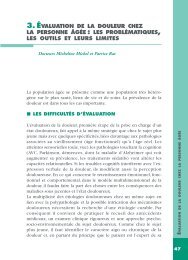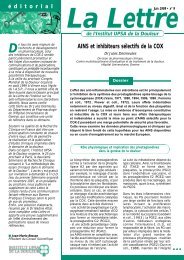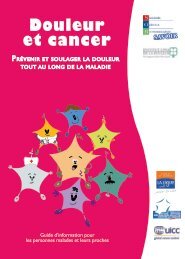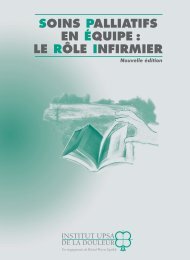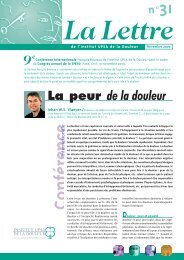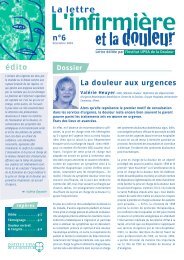Télécharger - Institut upsa de la douleur
Télécharger - Institut upsa de la douleur
Télécharger - Institut upsa de la douleur
You also want an ePaper? Increase the reach of your titles
YUMPU automatically turns print PDFs into web optimized ePapers that Google loves.
PRODUIT/VOIE<br />
paracétamol<br />
100 à 500 mg po<br />
codéine<br />
1 % sirop<br />
ou<br />
tramadol<br />
50 mg po<br />
célécoxib<br />
200 mg po<br />
REMARQUES<br />
7<br />
SECTEUR D’HOSPITALISATION<br />
RELAIS<br />
La prise d’antalgiques par voie orale est possible dès le retour en salle d’hospitalisation en l’absence <strong>de</strong> NVPO<br />
ALTERNATIVEs<br />
morphine<br />
5 mg/ml Sol buv<br />
morphine<br />
10 mg po<br />
tramadol<br />
50 mg po<br />
18<br />
paracétamol<br />
500 mg po<br />
+<br />
codéine<br />
30 mg po<br />
Chez l’adulte<br />
1 mg/kg/j en 4 - 6 prises<br />
10 mg x 6/j<br />
• 2 mg/kg/6-8 h chez l’enfant › 3 ans (Hors AMM) à <strong>la</strong> p<strong>la</strong>ce <strong>de</strong> <strong>la</strong> codéine<br />
• 1 - 2 cp x 2/j (forme à libération prolongée) chez l’adulte à <strong>la</strong> p<strong>la</strong>ce <strong>de</strong> <strong>la</strong> codéine<br />
ORDONNANCE DE SORTIE<br />
POSOLOGIE<br />
15 mg/kg/6 h Entretien <strong>de</strong> l’analgésie Systématique pendant<br />
7 à 10 jours chez l’enfant<br />
1 ml/kg/6 h Entretien <strong>de</strong> l’analgésie Systématique pendant<br />
2 mg/kg/6-8 h (enfant › 3 ans)<br />
1-2 cp x 2/j (adulte)<br />
Chez l’enfant<br />
1 mg/kg/j en 4-6 prises à <strong>la</strong> p<strong>la</strong>ce du nubain<br />
ou <strong>de</strong> <strong>la</strong> codéine<br />
BÉNÉFICES ATTENDUS<br />
Entretien <strong>de</strong> l’analgésie<br />
5 jours puis à <strong>la</strong> <strong>de</strong>man<strong>de</strong><br />
chez l’enfant<br />
Systématique pendant<br />
5 jours<br />
Puis à <strong>la</strong> <strong>de</strong>man<strong>de</strong><br />
chez l’enfant (Hors AMM)<br />
2 cp x 3/j Entretien <strong>de</strong> l’analgésie Systématique pendant<br />
7 à 10 jours chez l’adulte<br />
1 cp x 2 Entretien <strong>de</strong> l’analgésie Systématique pendant<br />
Analgésie <strong>de</strong> qualité<br />
REMARQUES<br />
7 à 10 jours chez l’adulte<br />
Risque cardiovascu<strong>la</strong>ire<br />
Respect <strong>de</strong>s contre<br />
indications<br />
• Conseils diététiques (alimentation liqui<strong>de</strong>, mixée, tiè<strong>de</strong> ou froi<strong>de</strong> - g<strong>la</strong>ces ou sucettes<br />
g<strong>la</strong>cées - réhydratation importante en évitant les boissons aci<strong>de</strong>s ou gazeuses)<br />
Reprise d’une alimentation normale à partir du 3 ème jour<br />
• Antibiothérapie (amoxicilline ou cefpodoxime) pendant 5 à 7 jours. Elle favorise une reprise<br />
plus rapi<strong>de</strong> <strong>de</strong> l’alimentation et d’une activité normale 19<br />
• Une cure courte <strong>de</strong> corticoï<strong>de</strong>s (1 mg/kg pendant moins <strong>de</strong> 7 jours) peut être proposée à visée<br />
antalgique et antiémétique 20<br />
AMBULATOIRE<br />
La chirurgie ambu<strong>la</strong>toire est possible. Elle ne se justifie que sous couvert d’une prise<br />
en charge optimale <strong>de</strong> <strong>la</strong> <strong>douleur</strong> postopératoire et d’une absence <strong>de</strong> NVPO<br />
Références bibliographiques<br />
1. Conférence <strong>de</strong> consensus. Prise en charge <strong>de</strong> <strong>la</strong> <strong>douleur</strong> chez l’adulte et l’enfant. Ann. Fr. Anesth. Réanim. 1998 ; 17 : 445-61.<br />
2. Warnock FF, Lan<strong>de</strong>r J. Pain progression, intensity and outcomes following tonsillectomy. Pain. 1998 ; 75 (1) : 37-45.<br />
3. Hamers JP, Abu-Saad HH. Children's pain at home following (a<strong>de</strong>no) tonsillectomy. Eur. J. Pain. 2002 ; 6 (3) : 213-9.<br />
4. Lowe D, van <strong>de</strong>r Meulen J, National Prospective Tonsillectomy Audit. Tonsillectomy technique as a risk factor for postoperative haemorrhage.<br />
Lancet 2004 ; 364 (9435) : 697-702.<br />
5. Marret E, F<strong>la</strong>hault A, Samama CM, Bonnet F. Effects of postoperative, nonsteroidal, antiinf<strong>la</strong>mmatory drugs on bleeding risk after<br />
tonsillectomy : meta-analysis of randomized, controlled trials. Anesthesiology. 2003 ; 98 (6) : 1497-502.<br />
6. Moiniche S, Kehlet H, Dahl JB. A qualitative and quantitative systematic review of preemptive analgesia for postoperative pain relief : the role<br />
of timing of analgesia. Anesthesiology 2002 ; 96 (3) : 725-41.<br />
7. Nikanne E, Kokki H, Salo J, Linna T. Celecoxib and ketoprofen for pain management during tonsillectomy : a p<strong>la</strong>cebo-controlled clinical trial.<br />
Oto<strong>la</strong>ryngol. Head Neck Surg. 2005 ; 132 (2) : 287-94.<br />
8. Steward DL, Welge JA, Myer CM. Do steroids reduce morbidity of tonsillectomy ? Meta-analysis of randomized trials. Laryngoscope.<br />
2001 ; 111 (10) : 1712-8.<br />
9. Afssaps http://afssaps.sante.fr<br />
10.Pen<strong>de</strong>ville PE, Von Montigny S, Dort JP, Veyckemans F. Double-blind randomized study of tramadol vs. paracetamol in analgesia after<br />
day-case tonsillectomy in children. Eur. J. Anaesthesiol. 2000 ; 17 (9) : 576-82.<br />
11. Hollis LJ, Burton MJ, Mil<strong>la</strong>r JM. Perioperative local anaesthesia for reducing pain following tonsillectomy. Cochrane Database Syst. Rev.<br />
2000 ; (2) : CD001874.<br />
12.Davis PJ et al. A randomized, double-blin<strong>de</strong>d study of remifentanil versus fentanyl for tonsillectomy and a<strong>de</strong>noi<strong>de</strong>ctomy surgery in pediatric<br />
ambu<strong>la</strong>tory surgical patients. Anesth. Analg. 2000 ; 90 (4) : 863-71.<br />
13.Moiniche S, Romsing J, Dahl JB, Tramer MR. Nonsteroidal antiinf<strong>la</strong>mmatory drugs and the risk of operative site bleeding after tonsillectomy :<br />
a quantitative systematic review. Anesth Analg. 2003 ; 96 (1) : 68-77.<br />
14.Sukhani R, et al. Ondansetron and do<strong>la</strong>setron provi<strong>de</strong> equivalent postoperative vomiting control after ambu<strong>la</strong>tory tonsillectomy<br />
in <strong>de</strong>xamethasone-pretreated children. Anesth. Analg. 2002 ; 95 (5) : 1230-5.<br />
15. Pin<strong>de</strong>r D, Hilton M. Dissection versus diathermy for tonsillectomy. Cochrane Database Syst. Rev. 2001 ; (4) : CD002211.<br />
16. Mercier C, Gouchet A, Laffon M. Anesthésie pour adénoï<strong>de</strong>ctomie et amygdalectomie chez l'enfant. Conférences d'actualisation <strong>de</strong> <strong>la</strong> SFAR<br />
1999 : 71-87.<br />
17. Fletcher D, Benoist JM, Gautron M, Guilbaud G. Isobolographic analysis of interactions between intravenous morphine, propacetamol,<br />
and diclofenac in carrageenin-injected rats. Anesthesiology. 1997 ; 87 : 317-26.<br />
18.Courtney MJ, Cabraal D. Tramadol vs diclofenac for posttonsillectomy analgesia. Arch. Oto<strong>la</strong>ryngol. Head Neck Surg. 2001 ; 127 (4) : 385-8.<br />
19.Burkart CM, Stewart DL. Antibiotics for reduction of posttonsillectomy morbidity : a meta-analysis. Laryngoscope. 2005 ; 115 (6) : 997-1002.<br />
20.Palme CE, Tomasevic P, Pohl DV. Evaluating the effects of oral prednisolone on recovery after tonsillectomy : a prospective, double-blind,<br />
randomized trial. Laryngoscope. 2000 ; 110 (12) : 2000-4.<br />
2540604-04/06<br />
ÉTABLISSEMENT<br />
Avec le parrainage <strong>de</strong> l’<br />
* Sous <strong>la</strong> responsabilité <strong>de</strong>s auteurs<br />
DATE DE DIFFUSION :<br />
PROCÉDURES POUR<br />
LA PRISE EN CHARGE<br />
DE LA DOULEUR<br />
POSTOPÉRATOIRE<br />
AMYGDALECTOMIE *<br />
COMITÉ SCIENTIFIQUE : Frédéric Aubrun - Dominique Fletcher - Christian Jayr - Agnès Bel<strong>la</strong>nger - Chantal Bernard<br />
RÉDACTEURS : Frédéric Aubrun - Marc Beaussier - Anissa Belbachir - Franck Bo<strong>la</strong>ndard - Gilles Boccara - Laurent<br />
De<strong>la</strong>unay - Nico<strong>la</strong>s Derro<strong>de</strong> - Dominique Fletcher - Elisabeth Gaertner - Olivier Gall - Christian Jayr - Hawa Keita-Meyer<br />
- Guy Kuhlman - Philippe Macaire - C<strong>la</strong>u<strong>de</strong> Mann - Emmanuel Marret - Olivier Mimoz - Cyrus Motamed - Marc Roucoules<br />
-Aimé - Catherine Spielvogel - François Sztark<br />
Douleur<br />
• Douleur postopératoire d’intensité sévère et <strong>de</strong> durée supérieure à 48 heures 1<br />
• EVA moyenne <strong>de</strong> 65 mm à J1 2<br />
• Durée prévisible : 7 à 10 jours 1,2 . Elle est maximale pendant les 4 premiers jours puis diminue<br />
progressivement 2<br />
• Douleur essentiellement liée à <strong>la</strong> lésion <strong>de</strong>s piliers amygdaliens auxquels adhèrent<br />
les amygdales (adhérences favorisées par les angines à répétition)<br />
• Douleur continue avec <strong>de</strong>s épiso<strong>de</strong>s paroxystiques et dynamiques lors <strong>de</strong> <strong>la</strong> stimu<strong>la</strong>tion<br />
<strong>de</strong>s piliers amygdaliens 3 . Ils sont responsables d’une sialorrhée, d’un refus <strong>de</strong> l’alimentation<br />
(<strong>douleur</strong> intense pendant <strong>la</strong> déglutition) et d’un mutisme chez certains enfants (lié aux <strong>douleur</strong>s<br />
lors <strong>de</strong> <strong>la</strong> phonation)<br />
• La <strong>douleur</strong> peut être responsable <strong>de</strong> troubles du sommeil (réveils multiples lors <strong>de</strong>s paroxysmes<br />
douloureux ou lors d’une déglutition nocturne) 3<br />
• Une <strong>douleur</strong> référée à type d’otalgie peut exister (notamment pendant <strong>la</strong> déglutition)<br />
Patient<br />
• 2 popu<strong>la</strong>tions :<br />
- Enfant : 4-10 ans<br />
- Adulte jeune : 25-35 ans<br />
• L’amygdalectomie peut être indiquée pour traiter un syndrome d’apnée du sommeil<br />
Ces patients nécessitent une surveil<strong>la</strong>nce particulière (hospitalisation)<br />
Chirurgie, rééducation<br />
• Durée d’hospitalisation très courte. Cette chirurgie peut être réalisée en ambu<strong>la</strong>toire ou avec<br />
une hospitalisation <strong>de</strong> 24 h (sortie à J1)<br />
• La principale complication <strong>de</strong> l’amygdalectomie est <strong>la</strong> reprise chirurgicale pour hémorragie<br />
(fréquence = 1 à 5 %). Le choix <strong>de</strong> <strong>la</strong> technique chirurgicale 4 ou <strong>de</strong> <strong>la</strong> stratégie analgésique peut<br />
avoir une influence sur cette complication 5<br />
• Chirurgie associée à un risque élevé (30-40 %) <strong>de</strong> nausées et <strong>de</strong> vomissements postopératoires (NVPO)
PRODUIT/VOIE<br />
ALTERNATIVEs<br />
PROCÉDURES POUR<br />
LA PRISE EN CHARGE<br />
DE LA DOULEUR<br />
POSTOPÉRATOIRE<br />
Après l’induction<br />
anesthésique<br />
Perfusion<br />
sur 15 min<br />
Après l’induction<br />
anesthésique<br />
IVL<br />
15 mg/kg<br />
(500 mg chez<br />
l’enfant);<br />
(1 g chez l’adulte)<br />
100 mg<br />
PRÉOPÉRATOIRE<br />
• Aucune technique d’analgésie préopératoire (« preemptive analgesia ») n’a fait <strong>la</strong> preuve<br />
<strong>de</strong> son efficacité 6<br />
• Certains traitements antalgiques disponibles uniquement par voie orale (célécoxib<br />
par exemple) peuvent être donnés en même temps que <strong>la</strong> prémédication 7<br />
<strong>de</strong>xaméthasone<br />
4 mg/ml iv<br />
paracétamol<br />
500 mg/1g iv<br />
parécoxib<br />
40 mg iv<br />
tramadol<br />
100 mg/2 ml iv<br />
néfopam<br />
20 mg ivl<br />
tramadol<br />
100 mg/2ml iv<br />
morphine<br />
1 mg/ml iv<br />
ropivacaïne<br />
0,2 %<br />
ou<br />
marcaïne<br />
0,25 %<br />
7<br />
8<br />
BLOC OPÉRATOIRE<br />
MODALITÉS POSOLOGIE BÉNÉFICES ATTENDUS REMARQUES<br />
Après l’induction<br />
anesthésique<br />
Après l’induction<br />
anesthésique<br />
IV directe<br />
PARENTÉRALE<br />
0,15 à 1 mg/kg<br />
(max 8 à<br />
25 mg)<br />
Diminution <strong>de</strong> <strong>la</strong> <strong>douleur</strong><br />
postopératoire, <strong>de</strong>s NVPO<br />
<strong>de</strong> moitié<br />
Alimentation plus facile<br />
Analgésie par anticipation<br />
40 mg Analgésie par anticipation Dé<strong>la</strong>i d’action : 10-20 min<br />
AMM chez l’adulte<br />
Les coxibs diminuent<br />
<strong>la</strong> <strong>douleur</strong> et les NVPO<br />
Risque cardiovascu<strong>la</strong>ire 9<br />
20 mg en IVL, utilisation chez l’adulte<br />
3 mg/kg peut être utilisée chez l’enfant (Hors AMM) 10<br />
Analgésie par anticipation<br />
200 µg/kg en fin d’intervention pour anticiper l’analgésie - Risque <strong>de</strong> NVPO<br />
Surveil<strong>la</strong>nce continue <strong>de</strong> <strong>la</strong> conscience, fréquence respiratoire et score <strong>de</strong> <strong>douleur</strong><br />
Utilisable<br />
chez l’adulte<br />
et l’enfant<br />
Dé<strong>la</strong>i d’action : 20-30 min<br />
Pic d’efficacité : 1 h<br />
Augmente le risque <strong>de</strong> NVPO<br />
Dé<strong>la</strong>i d’action : 20-30 min<br />
Pic d’efficacité : 1 h<br />
AMM chez l’adulte en IV<br />
• La réalisation d’une infiltration <strong>de</strong>s loges et <strong>de</strong>s piliers amygdaliens est controversée 11<br />
• L’efficacité n’est pas c<strong>la</strong>irement démontrée et ne dépasse pas 12 heures<br />
Risque d’injection <strong>de</strong>s anesthésiques locaux dans l’espace pharyngé <strong>la</strong>téral et<br />
postérieur responsable <strong>de</strong> paralysie <strong>de</strong>s cor<strong>de</strong>s vocales (atteinte nerf récurrent)<br />
et troubles <strong>de</strong> déglutition (nerf grand hypoglosse)<br />
REMARQUES<br />
• TYPE DE CHIRURGIE : <strong>la</strong> technique chirurgicale a une influence sur <strong>la</strong> <strong>douleur</strong> postopératoire. La dissection au bistouri<br />
électrique par rapport au bistouri froid est responsable d’un traumatisme plus important <strong>de</strong>s piliers. Les <strong>douleur</strong>s<br />
postopératoires sont plus intenses 15 . Des techniques <strong>de</strong> microdissection, <strong>de</strong> dissection au bistouri à ultrasons<br />
ou avec une cryothérapie peropératoire sont en cours d’évaluation<br />
• TYPE D'ANESTHÉSIE : <strong>la</strong> technique anesthésique requiert une anesthésie générale ba<strong>la</strong>ncée avec un contrôle <strong>de</strong>s voies<br />
aériennes 16<br />
PRODUIT/VOIE<br />
morphine<br />
1 mg/ml iv<br />
paracétamol<br />
500 mg/1 g iv<br />
parécoxib<br />
40 mg iv<br />
7<br />
17<br />
ALTERNATIVE<br />
nalbuphine<br />
20 mg/2 ml iv<br />
BLOC OPÉRATOIRE<br />
• L’utilisation <strong>de</strong> rémifentanil en peropératoire est associée à <strong>de</strong>s phénomènes<br />
d’hyperalgésie qu’il induit 12<br />
• Les AINS non sélectifs (kétoprofène, ibuprofène, diclofénac) commencés<br />
en pré ou postopératoire augmentent significativement le risque <strong>de</strong> reprise<br />
chirurgicale 5,13<br />
• La technique chirurgicale a une influence sur <strong>la</strong> <strong>douleur</strong> postopératoire (cf généralités).<br />
La dissection au bistouri électrique semble augmenter le risque <strong>de</strong>s hémorragies<br />
secondaires 4<br />
• L’ondansétron (50 µg/kg) diminue l’inci<strong>de</strong>nce <strong>de</strong>s NVPO (action synergique<br />
si utilisation conjointe <strong>de</strong> <strong>de</strong>xamathésone) 14<br />
PARENTÉRALE<br />
25 µg/kg/5-10 min<br />
ou<br />
2-3 mg/5-10 min<br />
(adulte)<br />
40 mg<br />
0,2 mg/kg<br />
SSPI<br />
MODALITÉS POSOLOGIE BÉNÉFICES ATTENDUS REMARQUES<br />
Titration par bolus<br />
dès EVA* ou OPS*<br />
› 3/10<br />
Perfusion<br />
sur 15 min<br />
IVD<br />
IVL sur 15 min<br />
Analgésie<br />
rapi<strong>de</strong> et efficace<br />
Risque <strong>de</strong> NVPO<br />
Chez l’enfant,<br />
un premier bolus<br />
<strong>de</strong> 100 µg/kg peut être<br />
réalisé si non réalisé<br />
en peropératoire<br />
15 mg/kg/6 h Action additive<br />
Si non prescrit<br />
si co-administration<br />
d’un morphinique<br />
Diminution <strong>de</strong> <strong>la</strong> <strong>douleur</strong><br />
postopératoire et NVPO<br />
Action synergique<br />
si co-administration<br />
d’un morphinique<br />
Risque <strong>de</strong> dépression<br />
respiratoire limité<br />
NEFOPAM, TRAMADOL, PARECOXIB n’ont pas l’AMM chez l’enfant<br />
NALBUPHINE est rarement utilisé chez l’adulte<br />
en peropératoire<br />
Si non prescrit<br />
en peropératoire<br />
AMM chez l’adulte<br />
Risque<br />
cardiovascu<strong>la</strong>ire 9<br />
* La <strong>douleur</strong> postopératoire est évaluée avec l’échelle OPS (Objective Pain Scale) chez les enfants <strong>de</strong> moins <strong>de</strong> 6 ans<br />
et avec l’échelle EVA (Echelle Visuelle Analogique après 6 ans (voir fiche « Evaluation <strong>de</strong> <strong>la</strong> DPO chez l’enfant).<br />
Peut être utilisée à<br />
<strong>la</strong> p<strong>la</strong>ce <strong>de</strong> <strong>la</strong> morphine<br />
AMM chez l’enfant<br />
PRODUIT/VOIE<br />
morphine<br />
1 mg/ml iv<br />
morphine<br />
10 mg/ml sc<br />
paracétamol<br />
1 g iv<br />
nalbuphine<br />
20 mg/2 ml iv<br />
parécoxib<br />
40 mg iv<br />
tramadol<br />
100 mg/2 ml iv<br />
AMYGDALECTOMIE<br />
SECTEUR D’HOSPITALISATION<br />
Perfusion<br />
sur 15 min<br />
Perfusion<br />
sur 20 min<br />
Perfusion<br />
sur 20 min<br />
15 mg/kg/6 h<br />
100 mg x 4-6/j<br />
Entretien <strong>de</strong> l'analgésie<br />
Entretien <strong>de</strong> l'analgésie<br />
Systématique chez l’enfant<br />
et l’adulte<br />
Epargne morphinique<br />
0,2 mg/kg/4 h Entretien <strong>de</strong> l'analgésie Systématique chez l’enfant<br />
Risque <strong>de</strong> dépression<br />
limitée<br />
AMM chez l’enfant<br />
Alternative à <strong>la</strong> morphine<br />
IVD 20 mg x 2/j Entretien <strong>de</strong> l'analgésie<br />
Les coxibs diminuent<br />
<strong>la</strong> <strong>douleur</strong> postopératoire<br />
après amygdalectomie<br />
et les NPVO<br />
AMM chez l’adulte<br />
Epargne morphinique<br />
Risque cardiovascu<strong>la</strong>ire 9<br />
NVPO fréquents<br />
AMM chez l’adulte<br />
Alternative à <strong>la</strong> morphine<br />
codéine<br />
1 % sirop<br />
paracétamol<br />
500 mg po<br />
+<br />
codéine<br />
30 mg po<br />
célécoxib<br />
200 mg po<br />
+/-<br />
+/-<br />
+/-<br />
+/-<br />
+/-<br />
+/-<br />
+/-<br />
+/-<br />
+/-<br />
+/-<br />
La prise d’antalgiques par voie orale est possible dès le retour en salle d’hospitalisation en l’absence <strong>de</strong> NVPO<br />
paracétamol Systématique 15 mg/kg/6 h Entretien <strong>de</strong> l'analgésie Préférer <strong>la</strong> forme buvable<br />
100 à 500 mg po<br />
chez l’enfant<br />
+/-<br />
+/-<br />
+/-<br />
7<br />
PCA**<br />
ou<br />
MODALITÉS POSOLOGIE BÉNÉFICES ATTENDUS REMARQUES<br />
Sous-cutanée<br />
PARENTÉRALE<br />
1-1,5 mg/bolus<br />
Pério<strong>de</strong> réfractaire :<br />
5-10 min<br />
10 mg x 4-6/j<br />
RELAIS<br />
Adaptation rapi<strong>de</strong><br />
aux besoins du patient<br />
Systématique 1 ml/kg/6 h Entretien <strong>de</strong> l'analgésie 1 ml = 1 mg<br />
Enfant ‹ 20 kg<br />
Per os 2 cp x 3/j<br />
Entretien <strong>de</strong> l'analgésie<br />
(posologie adulte) Analgésie ba<strong>la</strong>ncée<br />
Per os 1 cp x 2/j En comparaison aux<br />
AINS c<strong>la</strong>ssiques : même<br />
efficacité analgésique<br />
et diminution du nombre<br />
<strong>de</strong> reprise chirurgicale<br />
pour hémorragie<br />
Voir les alternatives au dos<br />
** PCA : patient controlled analgesia : analgésie contrôlée par le patient<br />
*** Dosages pour enfant : morphine 1 mg/ml IV, perfusion sur 15 min systématiquement 50 - 100 µg/kg/4h<br />
Surveil<strong>la</strong>nce continue<br />
<strong>de</strong> <strong>la</strong> conscience, fréquence<br />
respiratoire et score<br />
<strong>de</strong> <strong>douleur</strong><br />
Dosages pour l’adulte***<br />
Préférer <strong>la</strong> forme<br />
effervescente utilisable<br />
chez l’enfant › 20 kg<br />
et l’adulte<br />
Chez l’adulte<br />
Risque cardiovascu<strong>la</strong>ire 9<br />
Respect<br />
<strong>de</strong>s contre-indications


